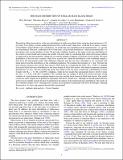THE MASS DISTRIBUTION OF STELLAR-MASS BLACK HOLES
Author(s)
Farr, Will M.; Sravan, Niharika; Cantrell, Andrew G.; Kreidberg, Laura; Bailyn, Charles D.; Mandel, Ilya; Kalogera, V.; ... Show more Show less
DownloadFarr-2011-The mass distributio.pdf (5.409Mb)
PUBLISHER_POLICY
Publisher Policy
Article is made available in accordance with the publisher's policy and may be subject to US copyright law. Please refer to the publisher's site for terms of use.
Terms of use
Metadata
Show full item recordAbstract
We perform a Bayesian analysis of the mass distribution of stellar-mass black holes using the observed masses of 15 low-mass X-ray binary systems undergoing Roche lobe overflow and 5 high-mass, wind-fed X-ray binary systems. Using Markov Chain Monte Carlo calculations, we model the mass distribution both parametrically—as a power law, exponential, Gaussian, combination of two Gaussians, or log-normal distribution—and non-parametrically—as histograms with varying numbers of bins. We provide confidence bounds on the shape of the mass distribution in the context of each model and compare the models with each other by calculating their relative Bayesian evidence as supported by the measurements, taking into account the number of degrees of freedom of each model. The mass distribution of the low-mass systems is best fit by a power law, while the distribution of the combined sample is best fit by the exponential model. This difference indicates that the low-mass subsample is not consistent with being drawn from the distribution of the combined population. We examine the existence of a "gap" between the most massive neutron stars and the least massive black holes by considering the value, M [subscript 1%], of the 1% quantile from each black hole mass distribution as the lower bound of black hole masses. Our analysis generates posterior distributions for M [subscript 1%]; the best model (the power law) fitted to the low-mass systems has a distribution of lower bounds with M [subscript 1%]>4.3 M ☉ with 90% confidence, while the best model (the exponential) fitted to all 20 systems has M [subscript 1%]>4.5 M ☉ with 90% confidence. We conclude that our sample of black hole masses provides strong evidence of a gap between the maximum neutron star mass and the lower bound on black hole masses. Our results on the low-mass sample are in qualitative agreement with those of Ozel et al., although our broad model selection analysis more reliably reveals the best-fit quantitative description of the underlying mass distribution. The results on the combined sample of low- and high-mass systems are in qualitative agreement with Fryer & Kalogera, although the presence of a mass gap remains theoretically unexplained.
Date issued
2011-11Department
MIT Kavli Institute for Astrophysics and Space ResearchJournal
Astrophysical Journal
Publisher
Institute of Physics/American Astronomical Society
Citation
Farr, Will M., Niharika Sravan, Andrew Cantrell, Laura Kreidberg, Charles D. Bailyn, Ilya Mandel, and Vicky Kalogera. “THE MASS DISTRIBUTION OF STELLAR-MASS BLACK HOLES.” The Astrophysical Journal 741, no. 2 (October 24, 2011): 103. © 2011 American Astronomical Society.
Version: Final published version
ISSN
0004-637X
1538-4357